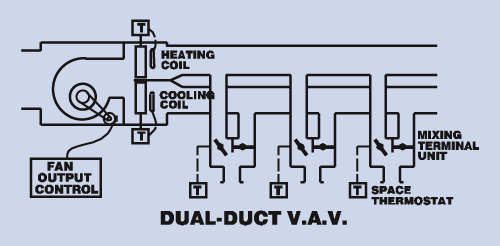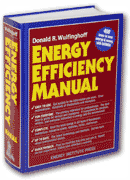Overview of…
4.8 Variable-Air-Volume Dual-Duct Systems
This part of the Energy Efficiency Manual shows you how to save energy in dual-duct variable air volume (VAV) air handling systems, also called double duct systems. VAV dual-duct systems have the potential of being efficient and comfortable, but they often have significant opportunities for improvement.
In dual-duct systems, the air handling unit has two coils, a continuously operating cooling coil and a continuously operating heating coil. The cooling coil feeds chilled air into a cold air duct. The heating coil feeds hot air into a hot air duct. The two ducts run in parallel throughout the building. At each space, air is tapped from the two ducts by a terminal unit. The terminal unit has a hot air damper and a cold air damper. When the space thermostat calls for heating, the hot air damper opens. When the thermostat calls for cooling, the cold air damper opens.
Efficiency suffers if a terminal unit mixes chilled air with heated under any conditions. The system may be designed to do this deliberately under low conditioning loads to maintain a minimum air flow into the spaces.
“Triple-duct” systems avoid air mixing. They are similar in appearance to dual-duct systems. The main difference is a third duct that carries unconditioned air (a mixture of return air and outside air) for mixing with either the heated air or the chilled air. If properly installed, triple-duct systems have no mixing losses, except for leakage that occurs inside the terminal units.
Here are the energy conservation measures for optimizing efficiency in VAV dual-duct systems. The largest opportunity for energy conservation in VAV double duct systems is eliminating any mixing of heated air and chilled air. Also, you can save fan energy by using accurate fan modulation to follow the cooling or heating loads. Variable-speed fans are the favored approach. VAV systems also allow you to use energy saving thermostatic controls, including deadband thermostats and temperature setback thermostats.
The dual-duct VAV system design is especially favorable for exploiting the energy saving principle of the outside air economizer cycle. Find the details here.
Click here to return to the Table of Contents


